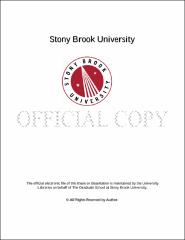| dc.identifier.uri | http://hdl.handle.net/11401/77777 | |
| dc.description.sponsorship | This work is sponsored by the Stony Brook University Graduate School in compliance with the requirements for completion of degree. | en_US |
| dc.format | Monograph | |
| dc.format.medium | Electronic Resource | en_US |
| dc.language.iso | en_US | |
| dc.publisher | The Graduate School, Stony Brook University: Stony Brook, NY. | |
| dc.type | Dissertation | |
| dcterms.abstract | Lake Turkana, Kenya is an understudied desert lake that receives over 90% of its inflow from the Omo River in Ethiopia. The volume and patterns of inflow from this river influence the lake’s chemistry and productivity, as well as the availability of habitat and the breeding migrations of its fishes. Lake Turkana is at the precipice of large-scale changes in ecological function due to climate change and economic development along the Omo River, including the construction of massive dams and irrigation projects. Upstream development will reduce the volume of water entering the lake and dampen the lake’s ecologically crucial seasonal flood pulse. These changes will almost certainly impact the lake’s fisheries at a time when they are becoming increasingly important to local livelihoods and national food security. This dissertation considers how the lake’s fish communities, which have not been well studied since the 1980’s, will respond to upstream development. Using data from satellite altimetry and local fisheries organizations, this study showed that water levels and their fluctuations are key drivers of fisheries productivity in the system. Using geographic information systems, water levels were shown to alter the distribution of habitat types and seasonal flood pulses to determine the extent of productive dynamic littoral habitat in the lake. Stable isotope analysis and a breeding vulnerability index for the top fishery species in the system showed that while some species of economic importance are ecologically flexible (e.g. Oreochromis niloticus. Lates niloticus), others (e.g. Tilapia zillii, Labeo horie) are highly sensitive to changes in habitat availability and food web structure. Lastly, a synthesis of published food web models for African lakes showed that altering the magnitude of water level fluctuations of these lakes has implications for their productivity, fish diversity, and the complexity, efficiency and connectivity of their food webs. Taken together, these studies suggest that upstream development will have extensive negative consequences for Lake Turkana and its fisheries. Although recommendations are made regarding minimizing impacts to the lake, more research must be conducted to comprehensively inform water resource management in the region. | |
| dcterms.abstract | Lake Turkana, Kenya is an understudied desert lake that receives over 90% of its inflow from the Omo River in Ethiopia. The volume and patterns of inflow from this river influence the lake’s chemistry and productivity, as well as the availability of habitat and the breeding migrations of its fishes. Lake Turkana is at the precipice of large-scale changes in ecological function due to climate change and economic development along the Omo River, including the construction of massive dams and irrigation projects. Upstream development will reduce the volume of water entering the lake and dampen the lake’s ecologically crucial seasonal flood pulse. These changes will almost certainly impact the lake’s fisheries at a time when they are becoming increasingly important to local livelihoods and national food security. This dissertation considers how the lake’s fish communities, which have not been well studied since the 1980’s, will respond to upstream development. Using data from satellite altimetry and local fisheries organizations, this study showed that water levels and their fluctuations are key drivers of fisheries productivity in the system. Using geographic information systems, water levels were shown to alter the distribution of habitat types and seasonal flood pulses to determine the extent of productive dynamic littoral habitat in the lake. Stable isotope analysis and a breeding vulnerability index for the top fishery species in the system showed that while some species of economic importance are ecologically flexible (e.g. Oreochromis niloticus. Lates niloticus), others (e.g. Tilapia zillii, Labeo horie) are highly sensitive to changes in habitat availability and food web structure. Lastly, a synthesis of published food web models for African lakes showed that altering the magnitude of water level fluctuations of these lakes has implications for their productivity, fish diversity, and the complexity, efficiency and connectivity of their food webs. Taken together, these studies suggest that upstream development will have extensive negative consequences for Lake Turkana and its fisheries. Although recommendations are made regarding minimizing impacts to the lake, more research must be conducted to comprehensively inform water resource management in the region. | |
| dcterms.available | 2017-09-20T16:53:34Z | |
| dcterms.contributor | Lwiza, Kamazima | en_US |
| dcterms.contributor | Pikitch, Ellen | en_US |
| dcterms.contributor | Aller, Josephine | en_US |
| dcterms.contributor | Champan, Demian | en_US |
| dcterms.contributor | Lee, Cindy | en_US |
| dcterms.contributor | Kaufman, Les. | en_US |
| dcterms.creator | Gownaris, Natasha Jeanne | |
| dcterms.dateAccepted | 2017-09-20T16:53:34Z | |
| dcterms.dateSubmitted | 2017-09-20T16:53:34Z | |
| dcterms.description | Department of Marine and Atmospheric Science. | en_US |
| dcterms.extent | 263 pg. | en_US |
| dcterms.format | Application/PDF | en_US |
| dcterms.format | Monograph | |
| dcterms.identifier | http://hdl.handle.net/11401/77777 | |
| dcterms.issued | 2015-05-01 | |
| dcterms.language | en_US | |
| dcterms.provenance | Made available in DSpace on 2017-09-20T16:53:34Z (GMT). No. of bitstreams: 1
Gownaris_grad.sunysb_0771E_12653.pdf: 7626343 bytes, checksum: 494307117ac7cbd9ea80d1f2c6348612 (MD5)
Previous issue date: 2015 | en |
| dcterms.publisher | The Graduate School, Stony Brook University: Stony Brook, NY. | |
| dcterms.subject | African Lakes, Food Webs, Lake Turkana, Omo River, Water Level Fluctuations | |
| dcterms.subject | Ecology | |
| dcterms.title | Understanding the Impacts of Changes in Water Inflow on the Fishes of Lake Turkana, Kenya | |
| dcterms.type | Dissertation | |

